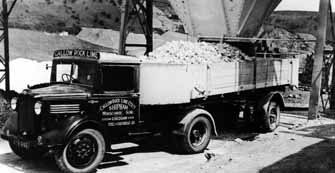
Aggregates industry
Mendip quarry history | Quarrying for building stone | Quarrying for early lime-burning | Quarrying for aggregate
Quarrying for aggregate

Limestone has been the main rock produced in Somerset and increasingly large proportions of this have been won from Mendip. Almost all the stone quarried is now used as aggregates, mainly for making roads (with andesite for the surface and limestone for the lower road courses) and for concrete. Many of the larger quarry operators now have specialised tar coating plants for road stone, or concrete block-works making a variety of concrete products.
Output until 1919 was generally below 0.5 million tonnes per year, but increased road building and construction in the interwar period caused it to be almost tripled by 1931. It then fluctuated over the next twenty years but rose from 2 to 3 million tonnes in the 1950s to a new peak of 12.6 million tonnes in 1973, largely on the basis of 'exports' to south-east England. Following the late 1980s construction boom, output rose to a peak of 18.8 million tonnes in 1990, but with falling demand, fell back to a level generally between 11.0 and 14.0 million tonnes per year. Somerset ranks third after Derbyshire and Leicestershire in terms of aggregates output. Since 1974, Somerset production of crushed rock has averaged about 10% of the national output.
Total permitted reserves of rock in Somerset quarries in 2003 were 671 million tonnes, equivalent to 54 years of production, almost exactly half of the regional total. As well as active quarries, the Somerset figure included reserves at about a dozen (mostly small) inactive sites.
- Home
- Overview maps
- Locality
areas
- Cheddar Gorge
- Charterhouse
- Blackdown
- Burrington Combe
- Shipham & Rowberrow
- Crook Peak & Axbridge
- Banwell to Churchill
- Priddy
- Harptree & Smitham Hill
- Draycott & Westbury-sub-Mendip
- Wookey Hole & Ebbor Gorge
- Wells
- Great Elm & Vallis Vale
- Mells & the Wadbury Valley
- The Vobster area
- The Whatley area
- Torr Works & Asham Wood
- Beacon Hill
- Stoke St Michael & Oakhill
- Holwell & Nunney
- Shepton Mallet & Maesbury
- Gurney Slade & Emborough
- The Nettlebridge valley
- Geology
- Minerals and mines
- Quarrying
- Caves and karst
- Biodiversity
- Detailed site information
- Acknowledgements
- External links
- Search
- Site map